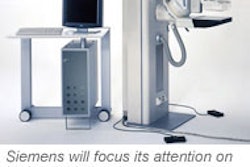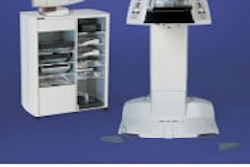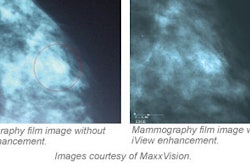William Dunlap, a radiologic technologist who got his start with mammography by performing xeromammography in the 1970s, shared his experience with digital imaging at the 2003 American Healthcare Radiology Administrators imaging center administrator conference in Tampa Bay, FL.
Digital mammography has shown great promise in comparison with conventional film-screen mammography. In diagnostic terms, the modality provides images that can be manipulated by radiologists in ways film simply cannot be. Contrast reversal, image enhancement, magnification without additional radiation exposure to the patient, image density reversal, and tissue equalization are a few of the image processing capabilities available with digital mammography.
However, the road to widespread adoption of the technology in the U.S. has proven to be a bumpy ride for those in the commercial healthcare sector.
"Although Health and Human Services has approved the use of digital mammography for screening mammograms, many insurance companies will not recognize the CPT codes for it," explained William Dunlap, managing partner of Epic Imaging in Portland, OR.
Dunlap, a radiologic technologist who got his start with mammography by performing xeromammography in the 1970s, shared his experience with digital imaging at the 2003 American Healthcare Radiology Administrators imaging center administrator conference in Tampa Bay, FL.
Digital benefits
"The long-term benefits of digital mammography are numerous," Dunlap said. "On an environmental basis, there are no processor chemicals that have to be disposed of. Electronic image transfer can be accomplished on a global basis within seconds, and provides us with remote diagnostic capabilities. Electronic archiving has virtually eliminated the issue of lost or damaged films. We’re also seeing a faster exam time with less repeats."
"On the diagnostic side, lesion conspicuity can be affected by contrast manipulations. Computer-aided detection (CAD) can be performed with higher resolution than film to improve the diagnostic accuracy," he added. "Prior studies are available for comparison on an almost instantaneous basis. And digital mammography provides the best mammographic density, a predictor of breast cancer risk.
Price and throughput
At his facilities, Dunlap has seen digital mammography reduce exam times by 50%-60%.
"Conventional exams with film take an average of about 10 minutes. With the use of a digital detector, we’re able to get exams completed in about 4 minutes," he noted.
Dunlap noted that digital mammography is currently an expensive technology when compared with conventional film-screen, with digital systems ranging from $350,000-$500,000 versus $80,000-$90,000 for traditional units. However, digital imaging increases the productivity of both the technologist on the acquisition end of the process, and the radiologist on the diagnostic end.
Based on a detailed cost analysis for his centers, Dunlap calculated that the breakeven point for converting to digital mammography in his area was around 9 patients per day.
Marketing
When marketing itself to referring physicians and the public in the Portland area, Epic Imaging has touted the digital modality. The group allocates 3% of its budget on advertising, and markets directly to patients via television, radio, and newspaper ads.
"We market all our modalities, including digital mammography and PET in our ads. Our television commercials cost us approximately $80,000 to shoot, and then about $55,000-$60,000 per month to run on local stations," Dunlap said.
The consumer and referring physician marketing campaigns have been a success for the practice. Dunlap’s imaging centers perform an average of 120 mammograms daily, and all of them are digital. Integration with RIS/PACS has enabled the imaging group to handle the digital mammography volume efficiently and effectively.
Insurance imbroglio
Getting reimbursed by some private healthcare insurers has been a thorny point in the otherwise rosy digital garden for Epic Imaging, according to Dunlap.
In July 2002, assessments by the Blue Cross and Blue Shield Association Technology Evaluation Center, as well as the Kaiser Foundation Health Plan, concluded that full-field digital mammography does not meet the criteria for reimbursement and is considered investigational for his area.
Dunlap said that the payors gave the following four reasons for denying reimbursement:
- The technology must have final approval from the appropriate governmental regulatory bodies.
- The scientific evidence must permit conclusions concerning the effect of the technology on health outcomes.
- The technology must be as beneficial as any established alternatives
- The improvement must be attainable outside the investigational settings.
But Dunlap’s group has found a way around this issue. With the use of a $16,000 dedicated printer, the digital images are printed out and then successfully reimbursed as a film mammogram. However, this has carried a substantial fiscal penalty for the practice, as the average reimbursement of $129.19 for digital mammography drops to $82.48 for film-screen mammography.
For imaging groups facing similar recalcitrance on the part of its private payors, Dunlap advocated joining forces with similar facilities in the area to promote the benefits of digital mammography with the payors and its clients.
"If we follow the logic the payors used in denying reimbursement, and digital mammography is conclusively proven superior to conventional mammography, will insurance companies no longer reimburse for film mammography?" Dunlap asked.
By Jonathan S. Batchelor
AuntMinnie.com staff writer
November 21, 2003
Related Reading
Women’s imaging vendors target flexibility, CAD enhancements, November 17, 2003
Detector size matters in mobile digital mammo screening, September 9, 2003
Contrast digital mammography helps visualize cancer in dense breasts, August 29, 2003
MCC finds no additional benefit for digital mammo, June 11, 2003
Shift to full-field digital units will spur mammography market, April 30, 2003
Copyright © 2003 AuntMinnie.com



















